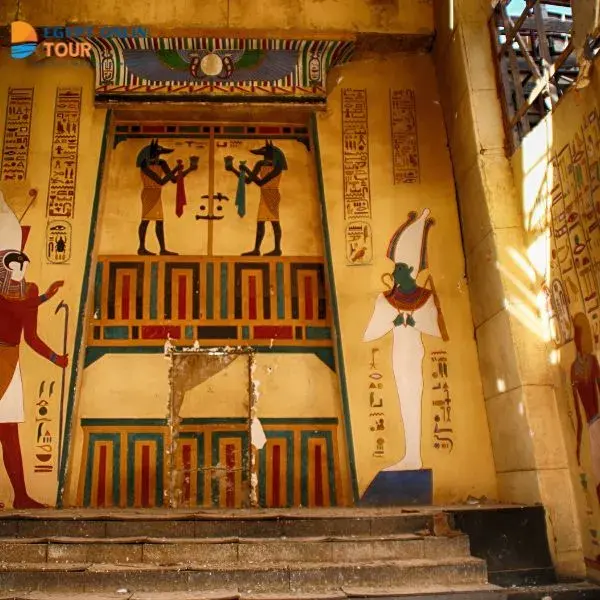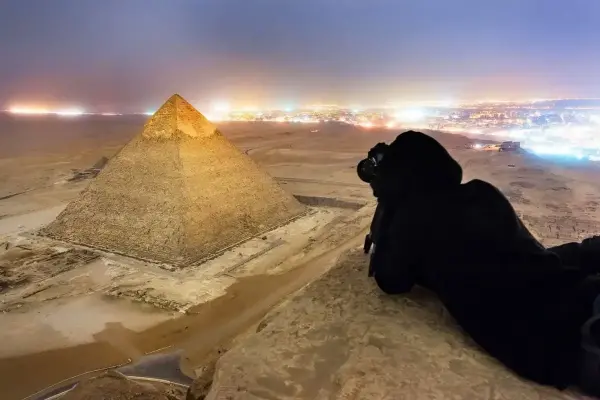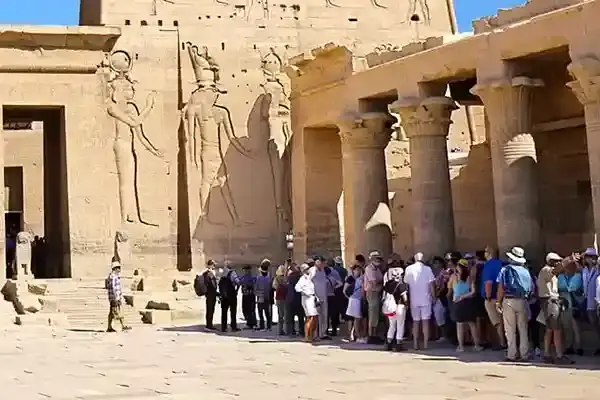Eclipse is a phenomenon that does not occur continuously and many of us see it as an extraordinary event to see as one of the exciting cosmic phenomena. The world follows: what day is the total eclipse of the nile 2027?
ِAs the eclipse provides an occasion to see effects that are generally delicate to see due to the gleam of the sun. Bright stars or plants similar to Venus and Jupiter may be visible near the sun in the sky.
Table of contents [Show]
- Solar eclipse Egypt
- It's a wonder: Ancient Egyptian Views on Solar Eclipses
- Here is an interesting historical story: The Function of Ra and the Solar Voyage
- The world's eyes are on Egypt: Preparing for the 2027 Egypt Total Solar Eclipse
- Why Egypt is an Ideal Spot for the 2027 Total Solar Eclipse
- Egypt Solar Eclipse 2027 tour
- Photography Tips for the 2027 Total Solar Eclipse in Egypt
- Where to See a Partial Solar Eclipse on August 2, 2027
- Summary
- FAQs
Solar eclipse Egypt

What is a solar eclipse?
The solar eclipse is an astrological phenomenon that occurs when the earth, the moon, and the sun are almost one straight, and the moon is in the middle during the time of the birth of the new moon when it is in the phase of the crater early in the lunar month so that the moon casts its shadow on the earth.
How does it happen?
Although the moon is 400 times smaller than the sun, it is 400 times closer to the earth than the sun from the earth, and because of this universe-controlled balance, the moon can block the sunlight, causing a total eclipse.
How often does a solar eclipse occur?
The solar eclipse occurs two to five times each year, but the total eclipse occurs every 18 months or so, and the eclipse shape varies depending on where it is viewed on Earth.
As Earth rotates, the shadow of the moon on Earth (and the eclipse scene) travels from the West to the East, this path is for areas experiencing total eclipse, and viewers in areas off the track see partial eclipses or no eclipses at all. The total solar eclipse is visible everywhere on Earth every 400 years.
How long does the solar eclipse last?

The Earth and the moon are in constant motion, so the eclipse is a temporary event, the longest total solar eclipse in modern history was on 11 July 1991 and lasted six minutes and 53 seconds. It can take several hours for the moon to pass in front of the sun, but the moment of total eclipse lasts only minutes, up to a maximum of seven minutes and 32 seconds.
What does an eclipse look like?
The total solar eclipse is a spectacular and unique experience, where the sun and the moon disk gradually cover it and the surrounding landscape becomes strangely dark, with a dim yellow light.
When the total eclipse occurs, the sun turns into a black disk but is surrounded by white threads representing the outer solar atmosphere, and a few minutes later the sun's disk returns to light up again as the moon moves away.
What are the different types of eclipses?
1- Total eclipse
A total solar eclipse occurs in the small patch of the Earth's surface that falls under the full moon and is called Umbra. During this eclipse the lunar disk passes right in front of the sun disk, blocking the entire sun's radiation and darkening the sky all as if it were time at night, but the solar halo, the outer atmosphere of the sun, will appear. This eclipse lasts for about five minutes, returning a diminished partial eclipse until the moon completes its crossing from the sun. The total eclipse takes a specific path due to the movement of the Earth and the moon.
2- Partial eclipse
It occurs in areas where the semi-shadow of the moon falls on the surface of the Earth, an area from which the entire disk of the sun is not seen, and where the sun's disk will not appear fully from these areas. The partial eclipse is increased when approaching the area (trajectory) of the total eclipse.
A partial solar eclipse occurs when the Earth, the moon, and the sun line up in a straight line, and the moon begins to pass in front of the sun, obscuring its radiation from the Earth, but the shadow of the moon is far too small to cover the entire Earth, so what happens to most of the Earth's regions is that it is situated in the semi-Moon. Penumbra, where the moon can block only a portion of the sun's radiation, and a partial eclipse may block the sun's disk in varying proportions, may block a quarter or half of it, or any percentage below the full.
3- Annular Eclipse
The annular solar eclipse is a phenomenon similar to a total eclipse, but with a small difference, This kind of eclipse occurs because the moon's orbit around the Earth is oval and not quite circular. The annular eclipse occurs when the moon is beyond Earth, or the Earth is closer to the sun than usual, or the two together, So the sun looks a little bigger than usual, while the moon looks a little smaller. Thus, when the moon disk crosses in front of the sun, it can’t completely obscure it, although it is seized in front of it, it remains a ring of radiation around it and it is called the "ring of fire", which is where the annular eclipse comes from, and it lasts almost the duration of the total eclipse.
4- Hybrid solar eclipse
A hybrid solar eclipse is called a total annular eclipse, which occurs when the moon is within a close enough space to reach the Earth's shadow, and the hybrid eclipse usually begins as an annular eclipse and then is completed to become complete.
Hybrid eclipses are rare (constituting only about 4 percent of solar eclipses). NASA information indicates that the last hybrid eclipse occurred on 20 April 2023, and was visible in Indonesia, Australia, Papua, and New Guinea.
It's a wonder: Ancient Egyptian Views on Solar Eclipses

The solar eclipse was associated with the ancient Pharaonic civilization, and ancient Egypt had its interpretations of this rare astronomical phenomenon, where the Australian journal Enchant Orgnez confirmed that Ancient Egyptians knew about the solar eclipse and interpreted this cosmic phenomenon thousands of years ago.
Ancient Egyptians first understood the nature and importance of the sun
The sun represents an important star in the lives of the ancient Egyptians. They have therefore directed many buildings in Egypt towards it, monitored it, used it in their calendar, determined the time through it, and also discovered the phenomenon of solar eclipse.
Ancient Egyptians directed several temples and buildings towards solar astronomical phenomena such as the Karnak Temple in Luxor, the Karnak Palace in Fayoum, and the Temple of Abu Simbel. The sunrise of the sun on the day of the winter solstice is common to the eastern entrance to the Temple of Karnak (December 21) and the sunset on the day of the summer solstice to the west entrance to the same temple (June 21).
Use the sun in their calendar
The ancient Egyptians were able to use the sun in their calendar, drawing their attention to the fact that there were three phenomena associated together in one moment, namely the arrival of the flood of the Niles and the burning appearance of the goddess Isis star and the sunrise, so this day was the first day of the ancient Egyptian year. It is genius that ancient Egyptians could observe this star just before sunrise, the day of the summer solstice, which is defined as 21 June.
Use the sun in time fixing
Ancient Egyptians used the sun to determine the time and relied on the sun's shadow in setting time by day using a stick or piece of wood and an obelisk. They called this time measurement method solar hour or shadow hour. Egyptians realized that the direction and length of the shadow varied over the years and were drawing down the stick or obelisk arches and stripes on the ground to measure the shadow. It is valuable to know that a shadow hour was found between the 10th and 8th centuries BC.
Understand the solar eclipse phenomenon
They also knew the course of the sun and filmed it in the Bruges-Dendra circle, which dates back to the first century B.C. As they knew the phenomenon of solar eclipse, the image of this eclipse changed throughout history, and in the legend the enemy of the Sun was depicted as a snake wrapped around itself and trying to swallow the sun and these are the oldest images of the eclipse.
Here is an interesting historical story: The Function of Ra and the Solar Voyage
Ra, also known as Aton, is one of the most respected gods in ancient Egypt, embodying the sun and creation. As the Sun God, his daily journey across the sky depicts the life cycle, death, and resurrection. The ancient Egyptians revered him as the king of the gods, as well as the shepherd of the pharaoh and the world's creator. Its importance can be overstated in Egyptian culture, where its influence permeates religion, kings, and understanding of life and the universe. Temples dedicated to the shepherd became centers of worship and learning, attracting followers who sought to honor his divine authority and wisdom.
How do the drawings show him?
The drawings often show him with a human body and a falcon head, capped by a sun disc surrounded by a Cobra viper, symbolizing his strength and protection. This imposing image reinforces Ra's status as a divine protector, supporting the cosmic system against the forces of chaos.
The surrounding myths are rich and varied, including the stories of his battle with snake Aviv and his night trip through the underworld. These tales convey the ancient Egyptians' understanding of the balance of the universe and the importance they placed on harmony in the universe. Through such novels, Ra's character as a trustee reflected the relentless and creative aspirations of Egyptians toward balance and renewal.
Take this opportunity and also learn about Grand Egyptian Museum Tour.
An incredible discovery:
In 1954, archaeologists found two roofed pits at the base of the southern pyramid of Khufu. After research and excavation, they found at the bottom of one of them an elaborate disassembled vessel carved from rice wood and connected with ropes, none of which lacked any part. After assembling the 1,224 parts of the vessel, they discovered that they had a Khufu ship or what's known as a "Sun boat."
The Sun cult, most notably in northern Egypt, spread during the Pharaoh Khufu era, and the Pharaoh kings began to call themselves the son of Ra from the age of Al-Ahram builders.
It is the time to discover Egypt Luxury Tours.
The world's eyes are on Egypt: Preparing for the 2027 Egypt Total Solar Eclipse

Where is the best place to see the eclipse in 2027?
Luxor: The ideal location for monitoring the "Eclipse of the century", where it will reach a maximum of 6 minutes and 22 seconds, features the Valley of the Kings, the Temple of Karnak, the Temple of Luxor, and the Temple of Hatshepsut and this area will certainly receive thousands of tourists.
Luxor City will experience the longest total solar eclipse in August 2027.
One of the most pressing aspects of this eclipse, especially for travelers, is the strategic location of the point of "greater eclipse" near Luxor, Egypt, The city of Luxor, at which the Nile River intersects, is Egypt's most wonderful treasures home, making it a perfect base for viewing the eclipse.
Don’t miss 8 Days Cairo to Abu Simbel and Back Overland.
Where are the most attractive places in Luxor?
Tourist attractions in Luxor include the Temple of Luxor, Abu al-Hol Street, and the Temple of Karnak, while on the western side of the River Nile is the Temple of Hatshepsut, the Valley of the Kings, and also the two statues of the giant Mennon.
Why Egypt is an Ideal Spot for the 2027 Total Solar Eclipse

Importance of the 2027 Egypt Total Solar Eclipse
MasterCard Institute of Economics revealed that Cairo stands out among the world's most popular destinations for travel at a time when the region is registering an unprecedented travel turnout.
Is it the time to receive bookings to follow the "eclipse of the century" in 2027?
Tour operators and cruise lines have already begun to receive bookings in preparation for the anticipated phenomenon, named as the "eclipse of the century." During the anticipated phenomenon, the "eclipse of the century", the moon will prevent the sunlight for 6 and a half minutes. The 260-kilometer-wide total solar eclipse will sweep through many popular sights around the world, including Egypt. On the other hand, individuals elsewhere in Europe, Africa, and the Middle East will witness the phenomenon of partial eclipse, where the moon will cover a larger part of the sun depending on how close to the "path of total eclipse."
Don’t miss this opportunity: learn about Egypt tour packages
Egypt Solar Eclipse 2027 tour
The solar eclipse in Egypt especially at Luxor, will be a great opportunity not only to see it clearly but also to enjoy Luxor, a city rich in history and spectacular scenes. It's your chance to have an exceptional experience.
Whether you choose a quick trip or a detailed trip, even if you spend one day, can leave you intrigued by Luxor's rich history and timeless beauty. You need to start planning your visit now and find out why this old city is a favorite of travelers from all over the world.
Did you know that Luxor offers more than just old wonders?
From exploring temples to sailing the Nile, it's a city full of unforgettable scenes!
Make unforgettable memories, and explore Egypt Classic Tours.
Luxor, a wonderful city in Egypt, is full of history and culture. But what should be done when you visit it? So much!
1- You can visit ancient temples in particular the Karnak Temple because it is among the largest worldwide.
2- You can visit the Valley of the Kings, the place where many pharaohs are buried. It offers an attractive glimpse of history.
3- You can take a cruise on the River Nile where spectacular scenes.
4- Moreover, the minors enjoy handicrafts that reflect Egyptian culture; making the purchase of souvenirs and gifts easy.
5- You can also enjoy delicious Egyptian food, and experience unforgettable food, and drinks. Lunch at a restaurant overlooking the Nile and relax.
Read about: What Is There to Do in Luxor
Photography Tips for the 2027 Total Solar Eclipse in Egypt
Medical sources reported that staring at the sun during an eclipse can burn the retina, and mild symptoms can include teary eyes, eye pain, headaches, and light sensitivity, but more serious symptoms include dull vision, blind spots, dim vision, distorted vision, and eye pain.
How to watch the eclipse safely?

Experts warn that it is unsafe to look directly at the bright sun without using specialized eye protection designed to look towards the sun. Viewing an eclipse through a camera lens, binoculars, or telescope without the use of a special solar filter can cause serious eye injury. Experts advise using safe sunglasses or hand-held sunglasses, noting that regular sunglasses are not safe to watch the sun. The only moment when eye protection can be safely removed during a total solar eclipse is the short time the moon blocks the sun's entire surface.
So the safe way to watch an eclipse is by wearing eclipse spectacles with light filters. According to international standards for glasses, they must be based on a rating of 14 and above, i.e. preventing 99% of UV rays and 97% of the visible spectrum.
Check about 8 Days Cairo, Luxor, Aswan Classic Tours.
Where to See a Partial Solar Eclipse on August 2, 2027
The solar eclipse will start across the eastern Atlantic and pass through the Strait of Gibraltar between Spain and Morocco. A total solar eclipse will occur in most of the central-eastern hemisphere on 2 August 2027. While partial eclipse will be visible in most parts of the eastern hemisphere.
It occurs when the sun, moon, and Earth are paved in a straight line. When the alignment is almost perfect, the cone of the moon's shadow touches the Earth's surface and obstructs the entire solar disk, at which point the eclipse is complete.
The next total eclipse will be on July 22, 2028. It can be seen in Australia and New Zealand. But it will be partly in Southeast Asia and East India.
It's worth noting that the 21st century (2001-2100) sees 224 solar eclipses, including 77 partial eclipses, 72 annular eclipses, 68 complete eclipses, and 7 mixed eclipses.
Perhaps you like: 5 Days Cairo to Luxor Tour Packages
Summary
After you know what day is the total eclipse of the Nile 2027, you are now fully prepared to start your planning to spend an incredible tour. Just rely on the Egypt online tour with all your travel arrangements for a smooth journey. Contact Us Now.
FAQs
What's the path of the solar eclipse in 2027?
While many parts of Europe, Africa, and South Asia will witness a partial eclipse, the total eclipse, where the sun is completely obscured by the moon, will be visible only along the narrow path of the moon’s umbral shadow passing through ten countries.
What eclipse happens every 360 years?
A total solar eclipse is a rare event, recreating nearly on Earth every 18 months on average, yet is estimated to reoccur at any given position only every 360–410 years on average.
What is the rarest eclipse?
A hybrid eclipse is especially rare because an annular eclipse can change to a Total eclipse, or vice versa, along the eclipse path. Due to Earth's curve, Earth may move through the Antumbral shadow (Annular eclipse) and Umbral shadow (Total eclipse) through different points of the eclipse path.
What eclipse takes 100 years?
Solar eclipses are fairly multitudinous, about 2 to 4 per year, but the area on the ground covered by summation is only about 50 miles wide. In any given position on Earth, a total eclipse happens only formerly every hundred years or so, though they can do as little as a few years apart for named locations.
Popular Categories
Related properties
Cairo, Aswan, and Luxor
-
Precio
$ 2,850
-
Tipo
Package
Cairo, Aswan, and Luxor
-
Precio
$ 1,850
-
Tipo
Package











